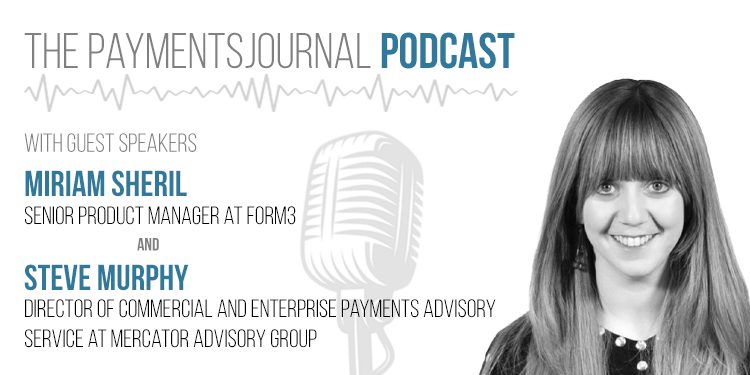Instantaneous movement is technically impossible, but real-time payments get pretty close.
Real-time payments (RTP) are financial transactions that are settled almost instantaneously. They use separate digital network “rails” to process payments 24/7 every day of the year. Real-time payments are fast, which is helpful to companies and individuals that either want to pay or receive funds on a moment’s notice.
In a recent podcast, PaymentsJournal discussed the current state of RTP in the U.S. with Miriam Sheril, Senior Product Manager at Form3, and Steve Murphy, Director of Commercial and Enterprise Payments at Mercator Advisory Group. They spoke about how The Clearing House Payments Company pioneered the first RTP network in the U.S. and provided insights into why faster payments are different in the UK compared with the U.S. Sheril also teased an upcoming webinar she’ll be hosting next month and what audiences can expect.
Evolution of Real-Time Payments Space
When looking at the real-time payments landscape, the U.S. has lagged other regions. By 2010 several countries already had real-time payment rails, including India, China, Japan, and the UK. In the U.S., however, the first — and only extant — real-time payments network was deployed in 2017 by The Clearing House Payments Company.
And since then, adoption of real-time payments has gradually increased. “The Clearing House has around 260 banks on the network right now,” said Sheril. “That doesn’t seem like a lot considering the U.S. has 10,000-plus financial institutions.”
Some of the reluctance to jump on board with The Clearing House RTP network is likely due to the alternative payments network the Federal Reserve is developing, called FedNow. That network has been in the works since 2019 and is slated to launch next year.
Banking institutions prefer to use Federal Reserve infrastructure because of its perceived stability and influence on the economy. That’s true in other payment network schemes as well. “The Federal Reserve service has 9,000-plus institutions on its ACH [automated clearing house] network, while the Clearing House EPN [electronic payments network] service, a competitor, has closer to 200,” said Sheril. “Many banks are going to wait until FedNow is out to really adopt real-time payments and launch it.”
Banks Offer RTP
According to Murphy, a minority of banks have started offering real-time payments, and those banks include some of the biggest players in the industry. “The 260 banks that are connected to RTP represent somewhere between 80% and 85% of account access,” said Murphy. “The large institutions have a direct connection into RTP. It’s the smaller banks that haven’t jumped in yet.”
Murphy added that most banks are partnering with a payments service provider (PSP) to connect into the real-time payments rail. For banks, it’s simpler and more cost-effective to contract out this out to a third party.
“When it comes to connecting to schemes, there’s a large cost for a bank to do it in-house,” said Sheril. “It all costs money — the connection itself, the messaging, meeting formatting standards, and using a collecting party service provider.”
Form3 takes care of the interface with the RTP network so banks can focus on banking, not information technology. “Even some of the larger banks who really have never looked at this model before are thinking, ‘Wait, this makes more sense for us to have someone else who does this. We’ll focus on banking instead.’”
When FedNow becomes available, it’s unclear whether banks will use both The Clearing House’s RTP and FedNow. Sheril believes banks will likely use both. While Murphy predicts that the two networks are not going to be 100% interoperable. PSPs such as Form3 will be helpful to banks in navigating the two networks.
Learning From Real-Time Payments in the UK
As the U.S. advances in its real-time payments journey, there’s debate about how much it can learn from other countries such as the UK.
The network in the UK was built with objectives in mind that don’t match the U.S. market. “As far as I know, it was more of a consumer-to-business and person-to-person transfer system and not as much business-to-business [B2B], which is one of the reasons why RTP was built the way it was built to create more B2B traffic,” said Murphy.
Sheril agreed. “Some of the use cases that work in the UK — and work really well — won’t hit here [in the U.S.].” For example, the UK has a standardized account numbering system for banks that makes it easy to do peer-to-peer (P2P) transactions. In the U.S., Sheril noted, “we may need some extra infrastructure or work-around that space.”
Sheril, along with Connie Blacklock, EMEA Head of Real-Time Payments at JPMorgan, will be further going into the similarities and differences between faster payments in the UK and the U.S. They’ll talk about how the move to real-time payments brings with it a need to adopt new technologies. And they discuss what banks need to consider from a fraud perspective.










